There are several decent, affordable lumber options available in the current market, with Douglas fir vs southern yellow pine (SYP) considered top contenders as far as softwoods go. For the purpose of this guide, we will compare these two common wood species by taking an in-depth look at their pros and cons, as well as how these features might impact your wood choice decision.
Related article: Cedar vs Douglas Fir
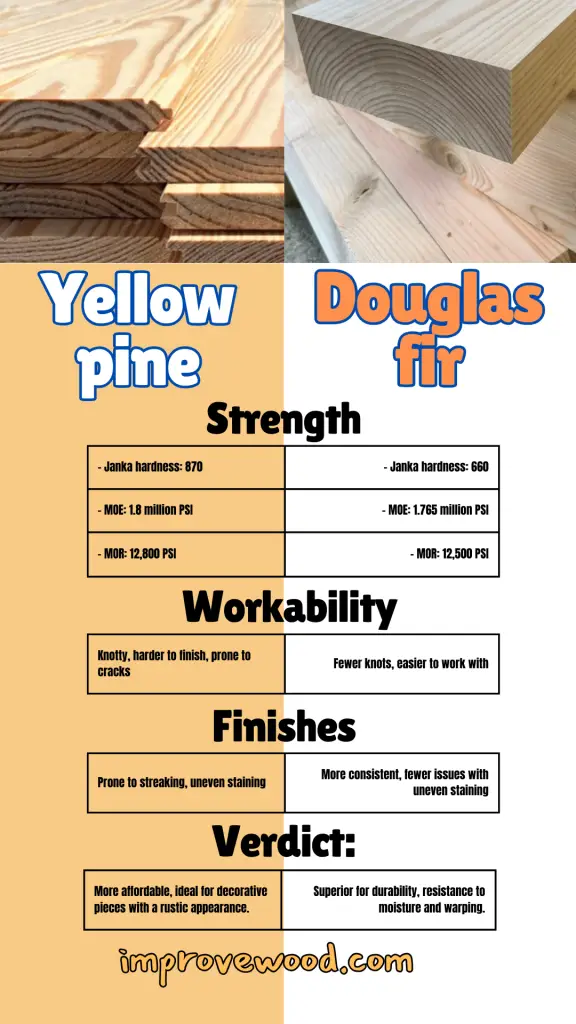
What Is Southern Yellow Pine?
SYP is a blanket terminology used in reference to specific pine species found in the regions east of the Great Plains and southern of the Mason-Dixon Line. In total, there are ten SYP species. However, four out of these ten species make up nearly 90% of America’s SYP lumber inventory. These include slash, longleaf, loblolly, and shortleaf. While all these four species are native to the Southern United States, the ponderosa and Jeffery SYP species are also relatively common in the timber market and are native to the drier Western United States.
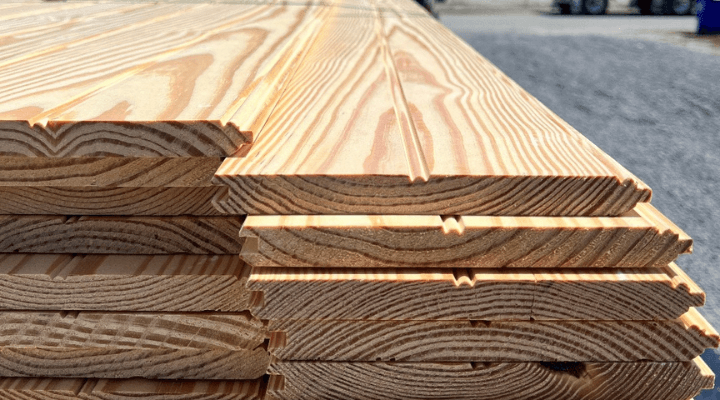
As its name suggests, SYP is renowned for its rich yellowish hue, which is coupled with a knot-filled grain pattern. In some cases, this color might fade into a warm amber. Either way, SYP’s unique appearance makes it a good choice for projects requiring a rustic aesthetic.
SYP timber is also hailed as the strongest pine in the market and one of the toughest softwoods in America. It is hard enough for most woodworking endeavors.
Uses
SYP is used for residential constructions, commercial constructions, furniture, and general woodworking projects. Not only is this wood dense and strong, but its unique cellular structure allows for deep penetration of treatment, making it one of the most preferred pressure-treated species. Therefore, it is commonly used in a wide range of constructions such as deck constructions, construction framings like trusses, raised wood floor foundations, and window trimmings.
Its rustic aesthetic and rich golden hue also make it suitable for decorative furniture pieces. It is also hard enough for ordinary furniture pieces, such as tables.
Read Next
• https://improvewood.com/southern-yellow-pine-vs-douglas-fir/
• https://improvewood.com/cedar-vs-pine/
• https://improvewood.com/douglas-fir-wood-overview/
• https://improvewood.com/redwood-vs-cedar/
• https://improvewood.com/what-is-the-most-weather-resistant-wood/
• https://improvewood.com/how-to-treat-wood-for-outdoor-use/
Advantages of Southern Yellow Pine
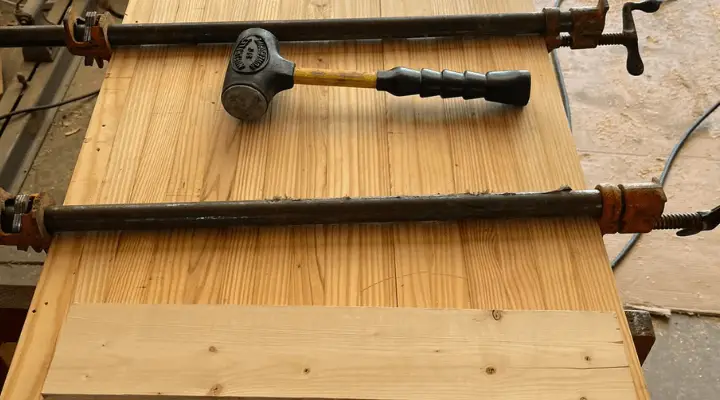
Environmentally Friendly
SYP is a good pick for the environmentally conscious. This timber is one of the most sustainably harvested and abundant wood resources in the country. Its trees take a relatively short time to reach merchantable size (around 16 years) and are renewed at a faster rate than they are harvested.
What’s more, SYP timber provides contractors and woodworkers with a renewable, bio-gradable, and non-toxic building resource.
Strength
SYP is a very strong wood with a high stiffness MOE (modulus of elasticity) of 1.8 million PSI and a similarly high MOR (modulus or rupture) of 12,800 psi. These statistics point to SYP’s immense strength as it can withstand significant bending stress and is a very stiff material.
Inexpensive
Compared to most softwoods, SYP costs much lesser. This makes it an ideal choice if you are on a tight budget.
Disadvantages of Southern Yellow Pine
Knotty
SYP wood contains a lot of knots. This tends to negatively affect the wood’s appearance and its structural stability. Knots create deviations in the wood’s fiber direction, creating abnormalities in its anatomical structure, weakening the wood, and distorting its appearance.
Knots also affect the wood’s workability since they are quite brittle, causing them to crack easily. As such, it is seemingly difficult to cut or shape SYP without forming cracks. It is also hectic to conceal the knots, even in the off chance that they do not form cracks or have holes.
However, some craftsmen do not mind SYP knots as they add character to some decorative wood pieces. To fill holes within the knots or cracks, such craftsmen use putty or epoxy.
Dents and Scratches Easily
As is expected of softwoods, SYP is significantly vulnerable to dings, scratches, and dents. This is largely due to its soft nature. This drawback is especially important for SYP used in high-traffic areas.
Susceptible to Pest and Insect Damage
SYP is vulnerable to attacks by wood-burrowing insects. An example is the pine wood nematode, which is endemic throughout Eastern America, and causes PWD (pine wilt disease).
What is Douglas Fir?
Just like SYP, Douglas fir is also considered one of the strongest softwoods available in North America. Also known as the Colombian Pine, this tree is not only found in large quantities in North America but also in South America and parts of New Zealand.
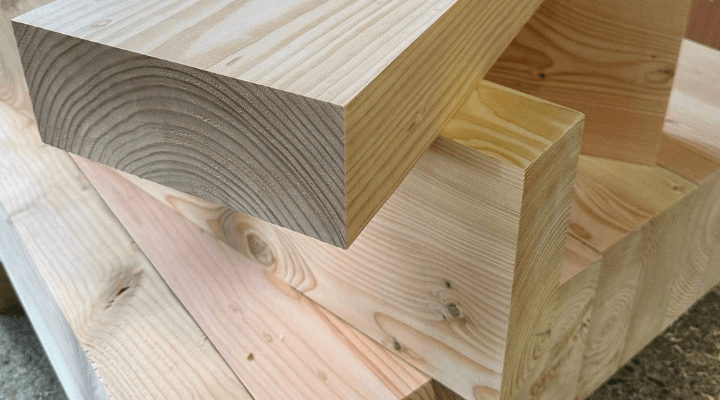
In addition to its strength, Douglas fir is also reputed for its durability. It is moisture-resistant and can naturally resist rot brought about by fungal organisms.
Uses
Given its attributes, Douglas fir is largely used for outdoor use. This includes water-based constructions, such as bridge parts or boat making, as well as commercial or residential constructions. In the latter, Douglas fir is used in framing, decks, patios, or fences, to name a few.
Fir wood can slowly be used for interior purposes. Given its non-toxic nature, wood is commonly used to make kitchen parts such as platforms and cutting boards. It is also used for millwork and flooring.
Advantages of Douglas Fir
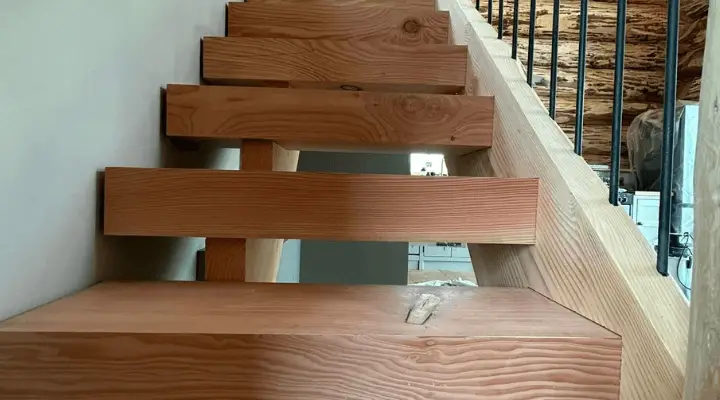
Appearance
This wood comes in a rich orange hue, formed by a mixture of reddish brown and creamy yellow colors, and has straight grains. This gives it an impressive appearance uniformity that blends well in modern and rustic setups.
Decay Resistance
Fir wood is also highly advantageous on account of its ability to resist decay brought about by fungal organisms. This innate resistance is caused by the presence of resins, most notably taxifolin, and phenolic extractives in the wood.
Noteworthy, these resins also give fir wood a distinct aroma and contribute to its reddish-brown color.
Despite its innate ability to resist decay, it is still not advisable to use fir wood for ground contact purposes without proper treatment.
Moisture Resistance
Douglas fir is one of the most moisture-resistant softwoods in the current market. Studies show that this timber can reach a maximum moisture limit of 21.8%, which is still not high enough to induce decomposition, in about 48 days. Inversely, normal softwoods, SYP included, reach a moisture content of 28%, sufficient for decomposition, in as little as 7 days. These figures show fir wood’s superiority in water resistance.
Strength
Fir wood offers immense strength as a building material. It has a reasonable Janka hardness rating of 660, a MOR of 12,500 IPS, and a MOE of 1.765 Million PSI.
Disadvantages of Douglas Fir
Prone to scratches and Dents
Being softwood, Fir wood’s soft nature makes it significantly susceptible to dents, dings, and scratches.
Costly
Compared to other alternatives, Douglas fir is considerably expensive. This is in part due to somewhat limited availability and shipping constraints.
Susceptible to Insect and Pest Damage
Fir wood is not resistant to wood-burrowing insects and pests. Perhaps the most notorious organisms, in this case, are the fir bark beetle and the large pine weevil.
Southern Yellow Pine vs Douglas Fir
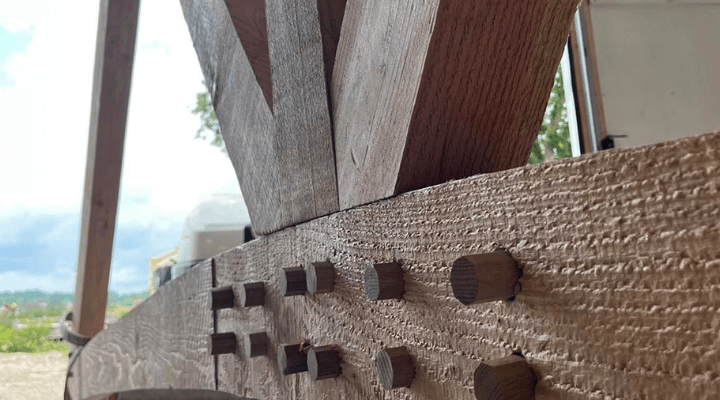
Strength and Durability
Douglas is slightly more durable than SYP. Although =both species are strong, Douglas fir is more resistant to moisture, meaning it is not greatly affected by rainy weather.
In the case strength, both woods are very strong but Douglas fir still stands out as the stronger option., SYP has a higher Janka hardness rating (870 compared to 660), but this difference is negligible since SYP still has a larger amount of softwood contained in its wider grade lines. Consequently, despite its superior hardness, SYP is more prone to shrinking, expanding, and warping.
Framing
Both the Douglas fir and SYP are good framing timber. They are both considered tier 1 heavy lifters in the softwoods’ bending strength category.
However, SYP has a slight advantage over fir wood due to its superior MOR (12800 psi compared to 12400 psi) and MOE (1.8 million psi compared to 1.75 psi).
Workability
Being softwoods, both kinds of wood are lightweight, making them easy to work with. Also, they accept stains well, plain well, machine accordingly, sand properly, and is easy to pound nails into them.
However, Douglas fir is more workable than SYP as the latter contains several knots. This makes it hard to finish, makes the wood more susceptible to cracks, and is very difficult to conceal.
The only drawback of both kinds of wood is that they have a high likelihood of spelching. This means the ends tend to splinter out frequently when cutting across a grain.
Finishes
Finishing SYP is a much more arduous task than finishing Douglas fir. This is because SYP’s smooth grain, high amounts of resin, and knots all work against you. In specific these factors make SYP highly prone to streaking when stained.
Additionally, although SYP stains easily due to its coarse texture, it is difficult to achieve a consistent finish as the dark knots and light wood sections create huge color variations.
Variations in the dryness of different regions within the wood also cause stains to get absorbed more in some areas than others, creating splotches.
Similarly, Douglas fir accepts finishes, stains, and glues well. Moreover, its coarse texture can cause the wood to stain unevenly. Fortunately, due to the lack of knots, you can easily solve this issue by applying a pre-stain wood conditioner to soften the timber’s fibers and allow for a uniform finish.
Southern Yellow Pine vs. Douglas Fir: Verdict
By and large, both kinds of wood are strong softwoods that can be used in various woodworking projects.
However, fir wood offers added durability since it is moisture-resistant and less prone to warping, shrinking, or expanding.
On the flip side, if you are looking for a more affordable option, SYP is definitely the best choice. Moreover, its rustic appearance makes it ideal for decorative pieces.